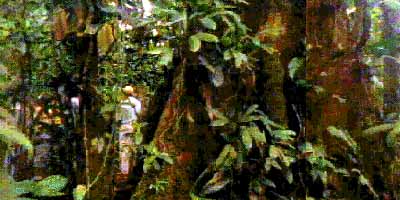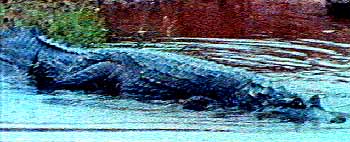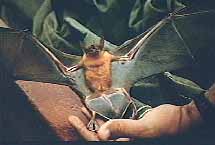
© copyright 2003 Michael P. Hamilton, Ph.D.
Bat hunting in a haunted hotel
July 21, 1987:
I kept thinking to myself, "were not lost, just disoriented..." while nearby a group of my students was attempting to read the instruction manual for the new high-tech satellite global positioning device that for some reason was not working. The rain had been incessant all afternoon, and compounded by a thick fog that shrouded this verdant slime-encrusted upper montane cloud forest, it was a little difficult to get around. Deep within the Henry Pettier National Park of Venezuela, our first lesson in tropical ecology was taking a slight detour into the realm of survival orienteering after our plan to save some time had gone awry.

a little disoriented in the montane cloud forest
Venezuela is a long way from Idyllwild, but there is no better way in the world for students to learn about the ecology of tropical ecosystems than to put them on a plane and let them spend six weeks in total immersion. For a number of years I participated in a unique educational exchange program where our students and faculty, who wanted to learn tropical ecology, and Venezuelan students interested in our southwest ecosystems, made their respective biological stations available for a one of a kind field-based experience. This year it was our turn to be hosted by the faculty of the Institute for Tropical Zoology in Caracas. Ten graduate students and professors from Cal Poly and UCR, were teamed with a similar number of Venezuelans, with the goal to study natural areas over the next six weeks. The itinerary was beyond ambitious when we learned that we would be snorkeling in Caribbean coral reefs, snow shoeing on Andean glaciers, bat trapping in rainforests, and birding in the Central Llanos. The highlight of our trip included an expedition into the Gran Sabana, a roadless wilderness of steaming jungles, unexplored Tepui mesas ("The Lost World" in Sir Arthur Conan Doyle's classic science fiction novel), and the home of a stone-age people, the Yanomami.

Our first encounter with a Venezuelan crocodile in the central llanos
We spent our first week at the Rancho Grande field station, jointly operated by the University of Venezuela and the National Park Service, and located inside the Henry Pettier National Park. Around 1950, the Rancho Grande Hotel was a personal project of a Venezuelan president whose dictatorship was prematurely overthrown, thus terminating the hotel construction before it was completed. Built from enormous steel beams and two feet thick concrete walls, the majority of the building is now the domain of climbing vines, towering tree ferns, colonies of bats and a perfusion of orchids. A small portion of the old hotel was refurbished to provide rustic sleeping and laboratory facilities, and being perched high on a steep mountain slope the upper rooftops provide a unique viewing spot for wildlife observations in the surrounding tree canopy.

A yet to be identified bat caught in our mist nests
The students and I eventually found our way back from our "hike," exhausted, but a lot wiser about taking care in a totally new environment. That evening Professor Ricardo Guerrero, a bat specialist, led us on a tour of the bat colonies of Rancho Grande. Belayed by climbing ropes, we were lowered through access holes in the concrete floors until we reached a colony of leaf-nosed bats clinging upside-down in a pitch black recesses of a high-ceiling room. We helped Ricardo set up his mist nets across the openings leading in and out of the room, and within the hour we began catching bats as they unknowingly collided with the fine nylon webbing. Three hours later we completed identifying, measuring, and placing wing tags on nearly three hundred bats.

Another bat from our survey of the interior rooms of the hotel
Lying in our hammocks at night, listening to howler monkeys, you can almost feel the pressure of the surrounding rain forest attempting to take back this hotel haunted by the memory of a long-dead dictator. What an adventure we had started, and this was only the beginning!
Want to learn more about Bats? Follow these links to some great sites!

